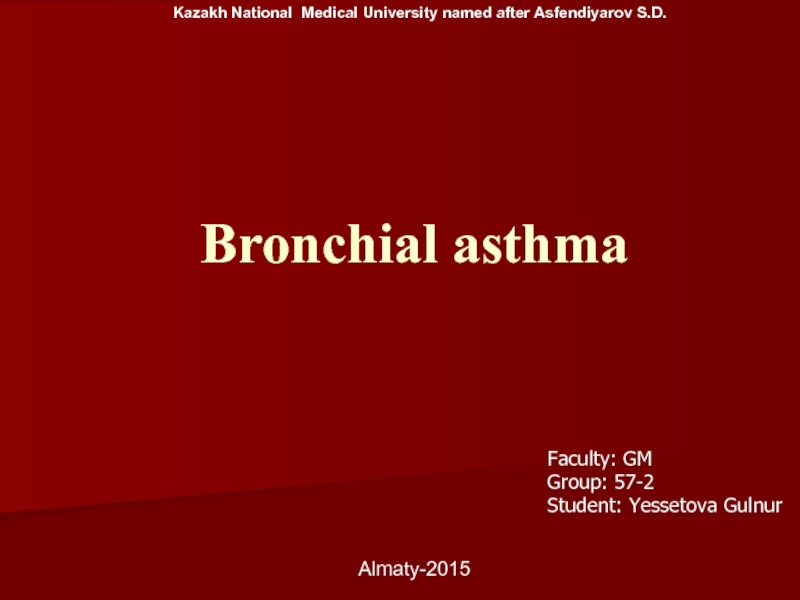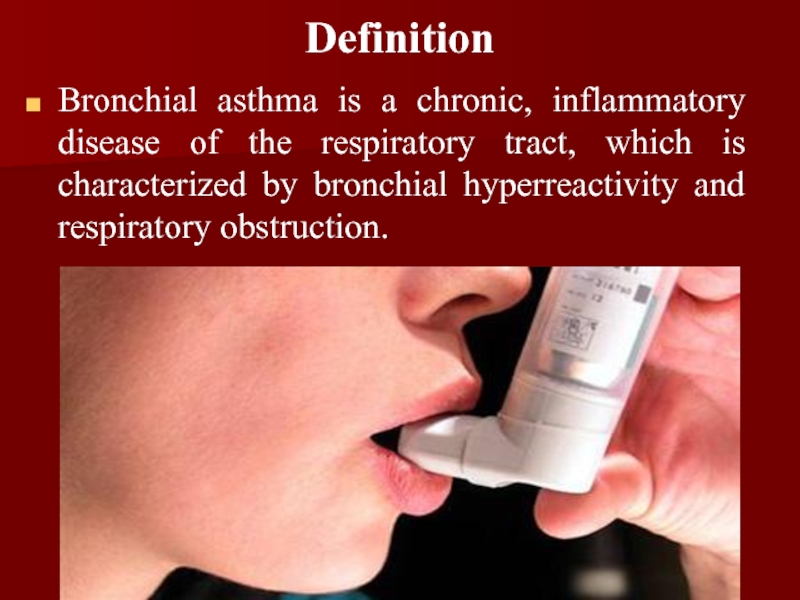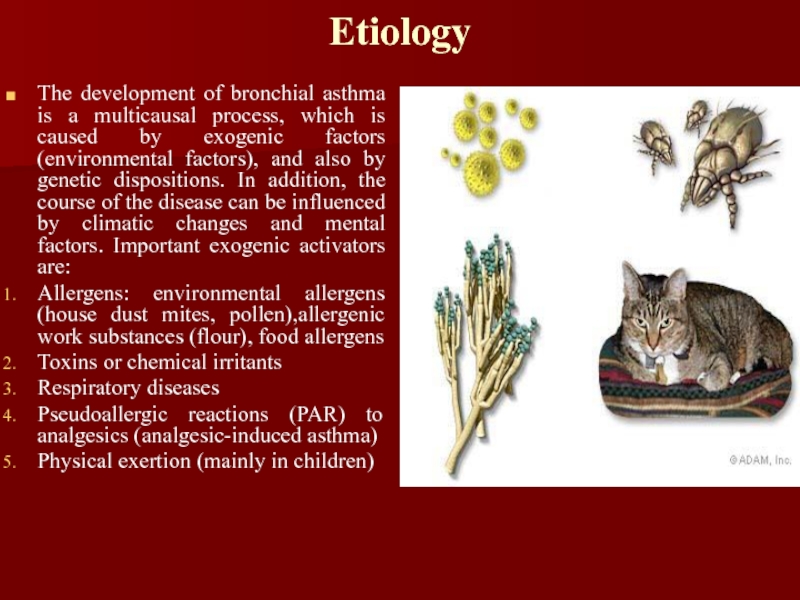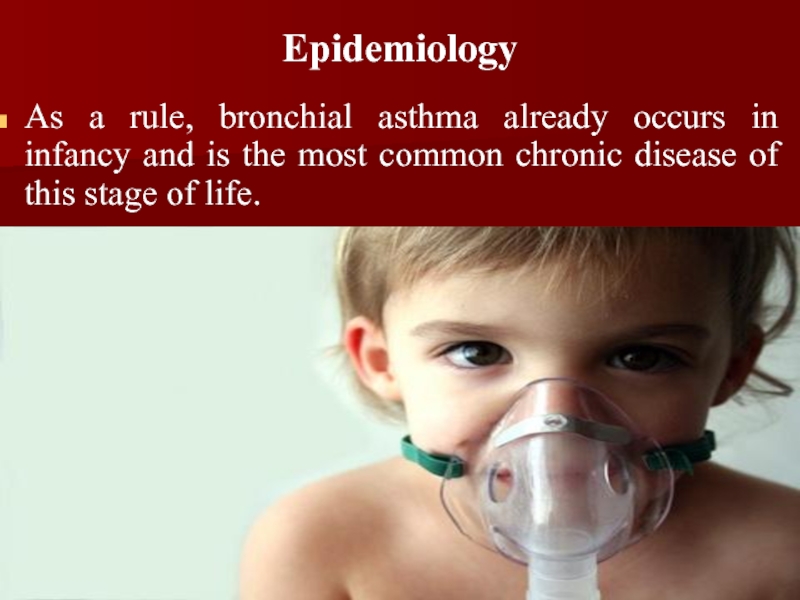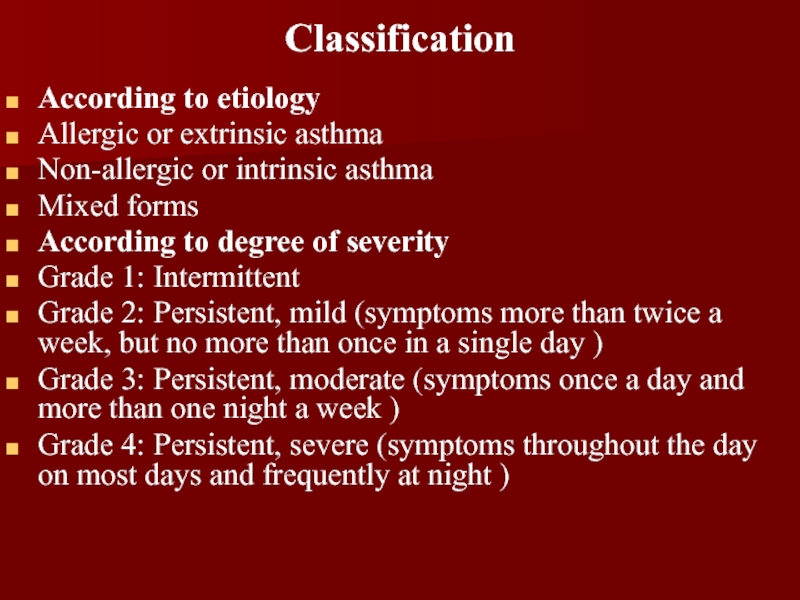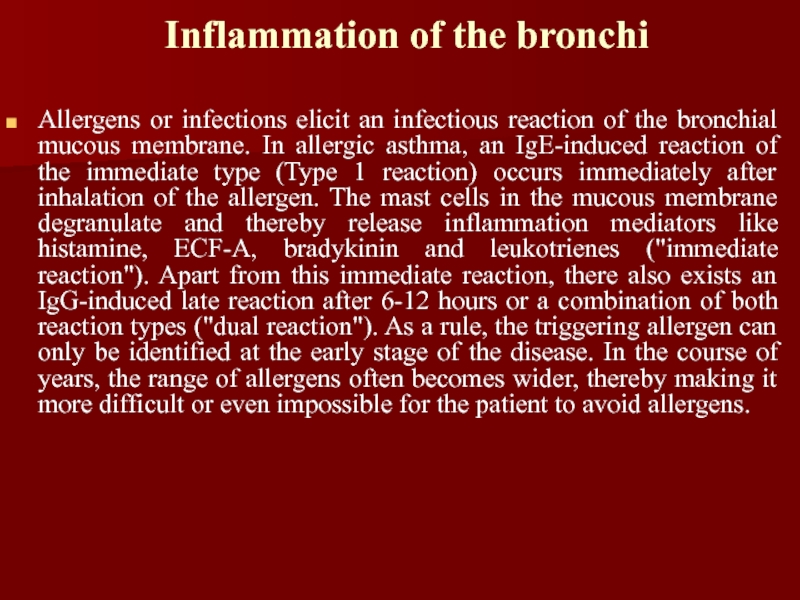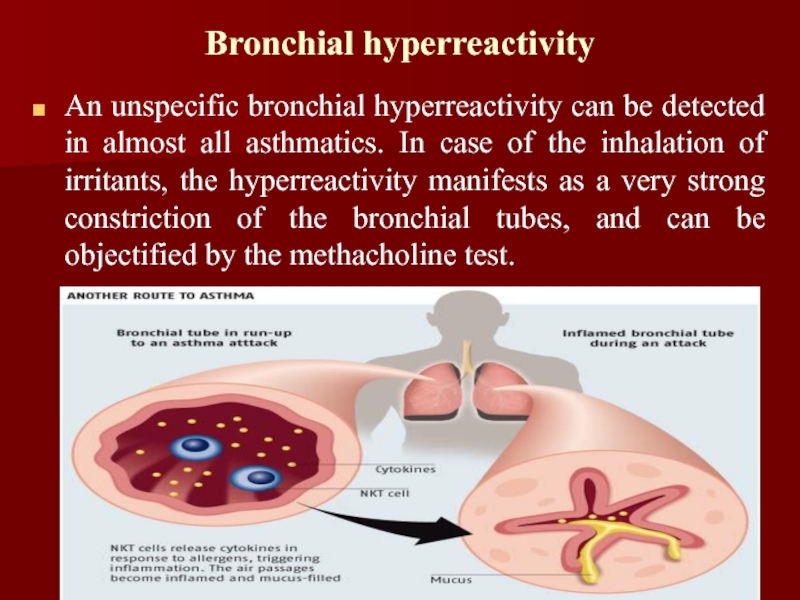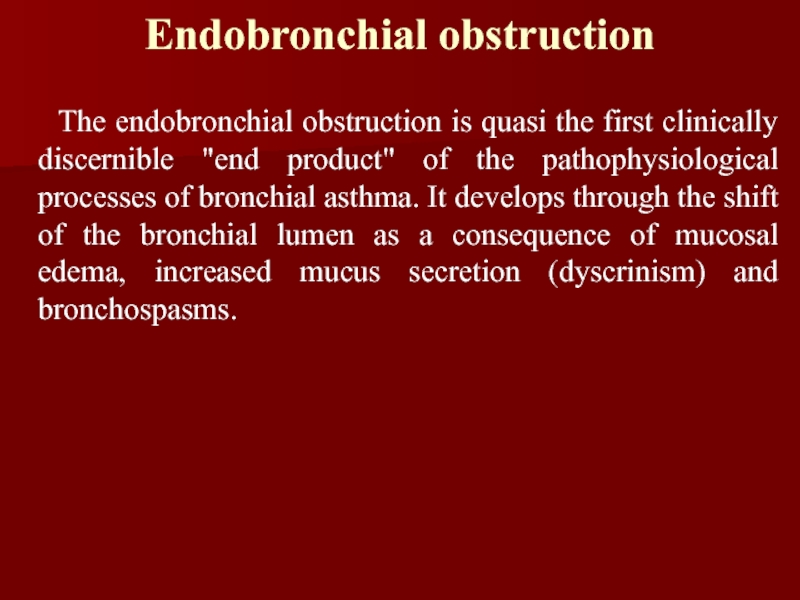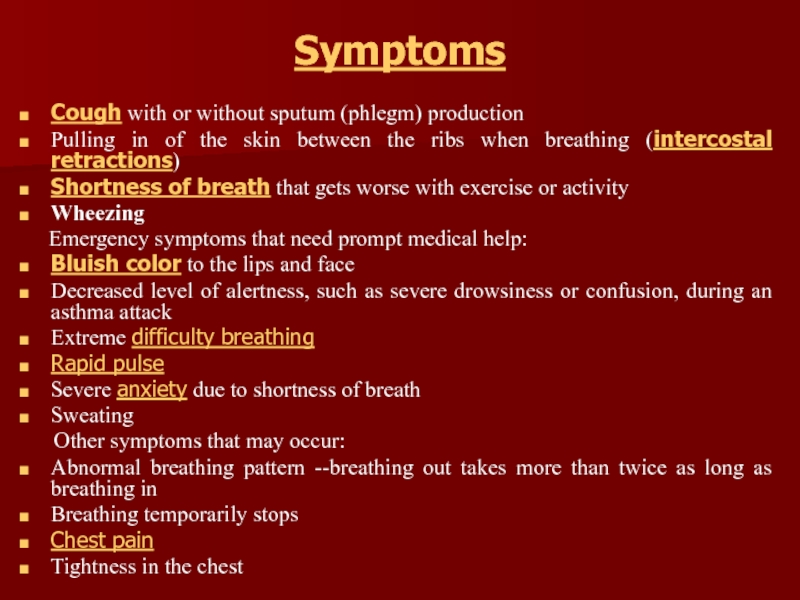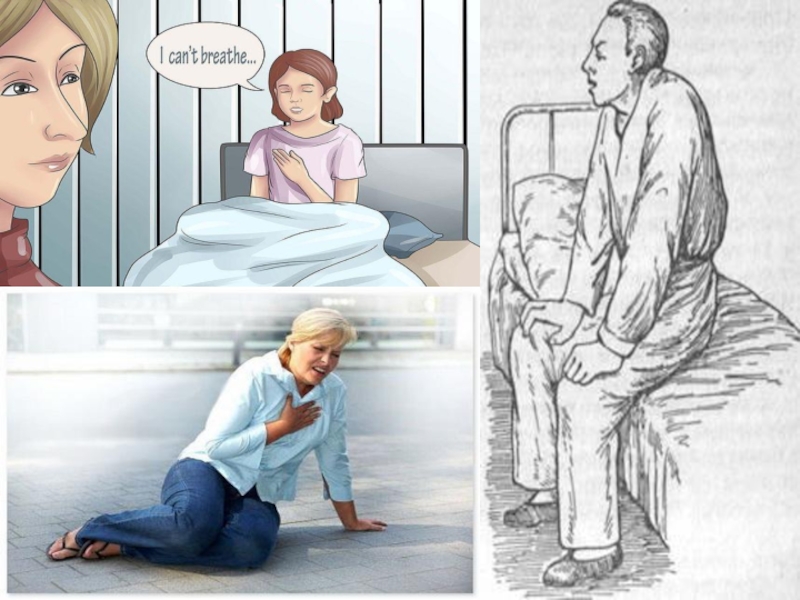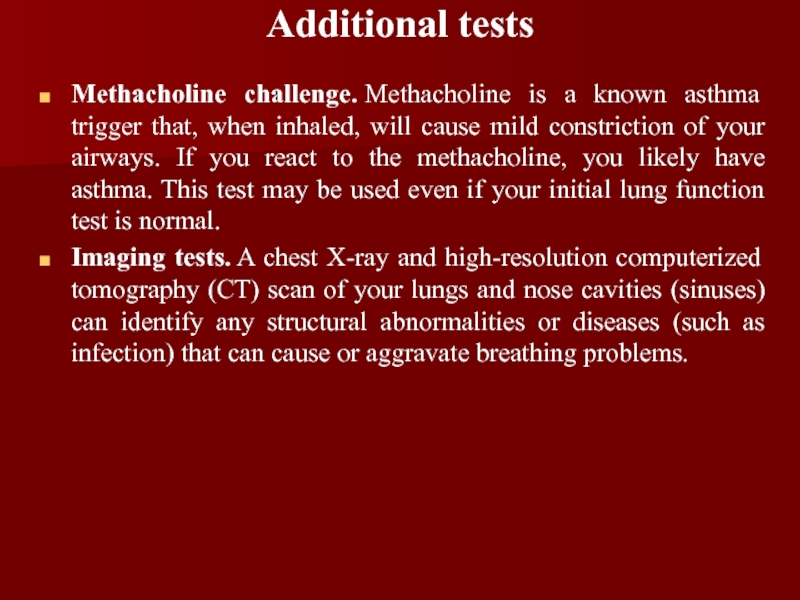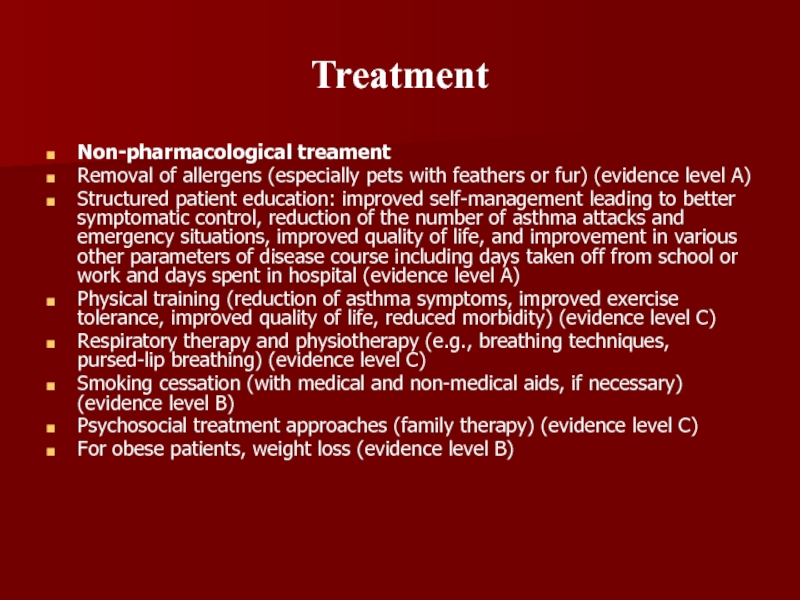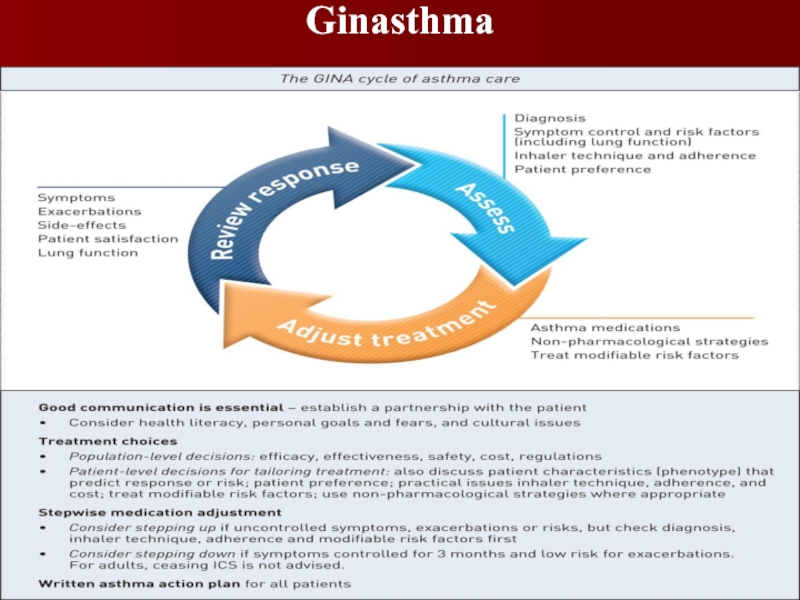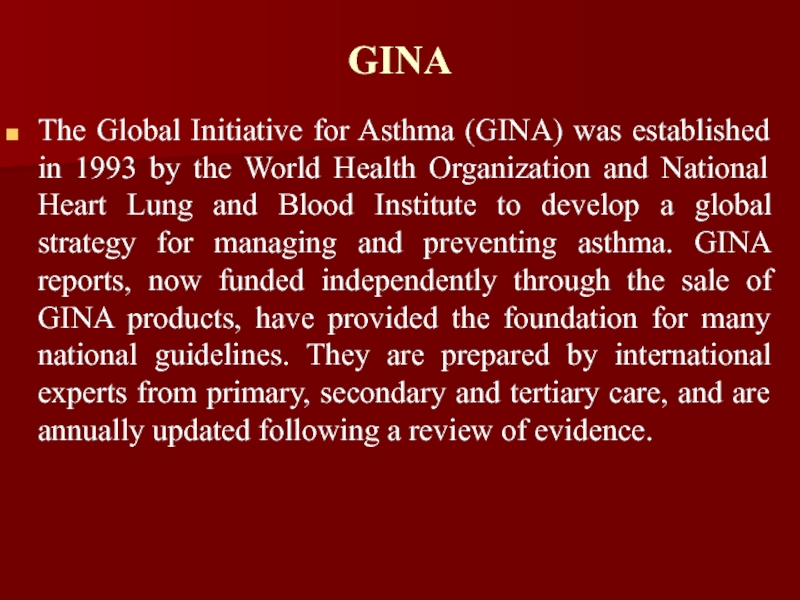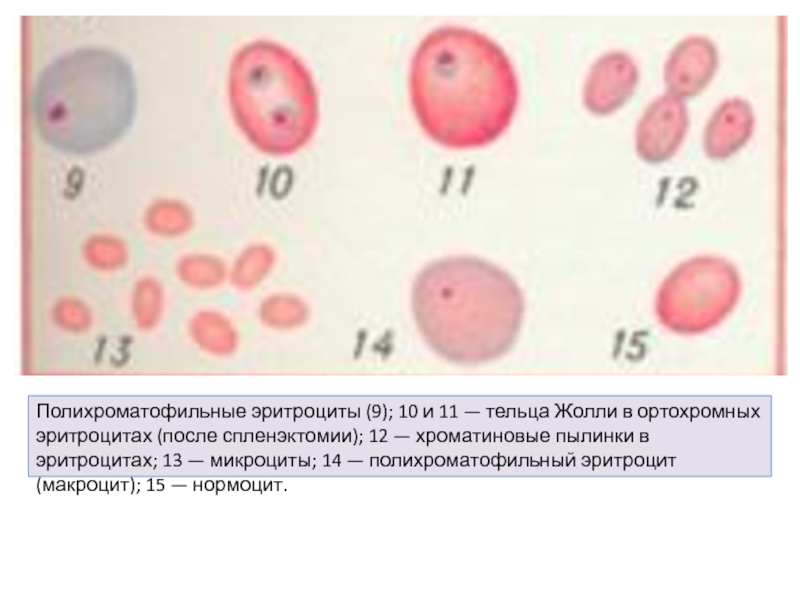National Medical University named after Asfendiyarov S.D.
- Главная
- Разное
- Дизайн
- Бизнес и предпринимательство
- Аналитика
- Образование
- Развлечения
- Красота и здоровье
- Финансы
- Государство
- Путешествия
- Спорт
- Недвижимость
- Армия
- Графика
- Культурология
- Еда и кулинария
- Лингвистика
- Английский язык
- Астрономия
- Алгебра
- Биология
- География
- Детские презентации
- Информатика
- История
- Литература
- Маркетинг
- Математика
- Медицина
- Менеджмент
- Музыка
- МХК
- Немецкий язык
- ОБЖ
- Обществознание
- Окружающий мир
- Педагогика
- Русский язык
- Технология
- Физика
- Философия
- Химия
- Шаблоны, картинки для презентаций
- Экология
- Экономика
- Юриспруденция
Bronchial asthma презентация
Содержание
- 1. Bronchial asthma
- 2. Definition Bronchial asthma is a chronic, inflammatory
- 3. Etiology The development of bronchial asthma
- 4. Epidemiology As a rule, bronchial asthma already
- 5. Classification According to etiology Allergic or
- 6. Pathophysiology Inflammation of the bronchi Bronchial hyperreactivity Endobronchial obstruction
- 7. Inflammation of the bronchi Allergens or
- 8. Bronchial hyperreactivity An unspecific bronchial hyperreactivity
- 9. Endobronchial obstruction The endobronchial
- 10. Symptoms Cough with or without sputum (phlegm)
- 12. Tests to measure lung function Spirometry. This
- 13. Additional tests Methacholine challenge. Methacholine is a
- 14. Additional tests Allergy testing. This can be
- 15. Treatment Non-pharmacological treament Removal of allergens (especially
- 16. Ginasthma
- 17. GINA The Global Initiative for Asthma (GINA)
- 18. Литература
Слайд 2Definition
Bronchial asthma is a chronic, inflammatory disease of the respiratory tract,
which is characterized by bronchial hyperreactivity and respiratory obstruction.
Слайд 3Etiology
The development of bronchial asthma is a multicausal process, which
is caused by exogenic factors (environmental factors), and also by genetic dispositions. In addition, the course of the disease can be influenced by climatic changes and mental factors. Important exogenic activators are:
Allergens: environmental allergens (house dust mites, pollen),allergenic work substances (flour), food allergens
Toxins or chemical irritants
Respiratory diseases
Pseudoallergic reactions (PAR) to analgesics (analgesic-induced asthma)
Physical exertion (mainly in children)
Allergens: environmental allergens (house dust mites, pollen),allergenic work substances (flour), food allergens
Toxins or chemical irritants
Respiratory diseases
Pseudoallergic reactions (PAR) to analgesics (analgesic-induced asthma)
Physical exertion (mainly in children)
Слайд 4Epidemiology
As a rule, bronchial asthma already occurs in infancy and is
the most common chronic disease of this stage of life.
Слайд 5Classification
According to etiology
Allergic or extrinsic asthma
Non-allergic or intrinsic asthma
Mixed forms
According
to degree of severity
Grade 1: Intermittent
Grade 2: Persistent, mild (symptoms more than twice a week, but no more than once in a single day )
Grade 3: Persistent, moderate (symptoms once a day and more than one night a week )
Grade 4: Persistent, severe (symptoms throughout the day on most days and frequently at night )
Grade 1: Intermittent
Grade 2: Persistent, mild (symptoms more than twice a week, but no more than once in a single day )
Grade 3: Persistent, moderate (symptoms once a day and more than one night a week )
Grade 4: Persistent, severe (symptoms throughout the day on most days and frequently at night )
Слайд 6Pathophysiology
Inflammation of the bronchi
Bronchial hyperreactivity
Endobronchial obstruction
Слайд 7Inflammation of the bronchi
Allergens or infections elicit an infectious reaction of
the bronchial mucous membrane. In allergic asthma, an IgE-induced reaction of the immediate type (Type 1 reaction) occurs immediately after inhalation of the allergen. The mast cells in the mucous membrane degranulate and thereby release inflammation mediators like histamine, ECF-A, bradykinin and leukotrienes ("immediate reaction"). Apart from this immediate reaction, there also exists an IgG-induced late reaction after 6-12 hours or a combination of both reaction types ("dual reaction"). As a rule, the triggering allergen can only be identified at the early stage of the disease. In the course of years, the range of allergens often becomes wider, thereby making it more difficult or even impossible for the patient to avoid allergens.
Слайд 8Bronchial hyperreactivity
An unspecific bronchial hyperreactivity can be detected in almost all
asthmatics. In case of the inhalation of irritants, the hyperreactivity manifests as a very strong constriction of the bronchial tubes, and can be objectified by the methacholine test.
Слайд 9Endobronchial obstruction
The endobronchial obstruction is quasi the first clinically
discernible "end product" of the pathophysiological processes of bronchial asthma. It develops through the shift of the bronchial lumen as a consequence of mucosal edema, increased mucus secretion (dyscrinism) and bronchospasms.
Слайд 10Symptoms
Cough with or without sputum (phlegm) production
Pulling in of the skin
between the ribs when breathing (intercostal retractions)
Shortness of breath that gets worse with exercise or activity
Wheezing
Emergency symptoms that need prompt medical help:
Bluish color to the lips and face
Decreased level of alertness, such as severe drowsiness or confusion, during an asthma attack
Extreme difficulty breathing
Rapid pulse
Severe anxiety due to shortness of breath
Sweating
Other symptoms that may occur:
Abnormal breathing pattern --breathing out takes more than twice as long as breathing in
Breathing temporarily stops
Chest pain
Tightness in the chest
Shortness of breath that gets worse with exercise or activity
Wheezing
Emergency symptoms that need prompt medical help:
Bluish color to the lips and face
Decreased level of alertness, such as severe drowsiness or confusion, during an asthma attack
Extreme difficulty breathing
Rapid pulse
Severe anxiety due to shortness of breath
Sweating
Other symptoms that may occur:
Abnormal breathing pattern --breathing out takes more than twice as long as breathing in
Breathing temporarily stops
Chest pain
Tightness in the chest
Слайд 12Tests to measure lung function
Spirometry. This test estimates the narrowing of your
bronchial tubes by checking how much air you can exhale after a deep breath and how fast you can breathe out.
Peak flow. A peak flow meter is a simple device that measures how hard you can breathe out. Lower than usual peak flow readings are a sign your lungs may not be working as well and that your asthma may be getting worse. Your doctor will give you instructions on how to track and deal with low peak flow readings.
Peak flow. A peak flow meter is a simple device that measures how hard you can breathe out. Lower than usual peak flow readings are a sign your lungs may not be working as well and that your asthma may be getting worse. Your doctor will give you instructions on how to track and deal with low peak flow readings.
Слайд 13Additional tests
Methacholine challenge. Methacholine is a known asthma trigger that, when inhaled,
will cause mild constriction of your airways. If you react to the methacholine, you likely have asthma. This test may be used even if your initial lung function test is normal.
Imaging tests. A chest X-ray and high-resolution computerized tomography (CT) scan of your lungs and nose cavities (sinuses) can identify any structural abnormalities or diseases (such as infection) that can cause or aggravate breathing problems.
Imaging tests. A chest X-ray and high-resolution computerized tomography (CT) scan of your lungs and nose cavities (sinuses) can identify any structural abnormalities or diseases (such as infection) that can cause or aggravate breathing problems.
Слайд 14Additional tests
Allergy testing. This can be performed by a skin test or
blood test. Allergy tests can identify allergy to pets, dust, mold and pollen. If important allergy triggers are identified, this can lead to a recommendation for allergen immunotherapy.
Provocative testing for exercise and cold-induced asthma.In these tests, your doctor measures your airway obstruction before and after you perform vigorous physical activity or take several breaths of cold air.
Provocative testing for exercise and cold-induced asthma.In these tests, your doctor measures your airway obstruction before and after you perform vigorous physical activity or take several breaths of cold air.
Слайд 15Treatment
Non-pharmacological treament
Removal of allergens (especially pets with feathers or fur) (evidence
level A)
Structured patient education: improved self-management leading to better symptomatic control, reduction of the number of asthma attacks and emergency situations, improved quality of life, and improvement in various other parameters of disease course including days taken off from school or work and days spent in hospital (evidence level A)
Physical training (reduction of asthma symptoms, improved exercise tolerance, improved quality of life, reduced morbidity) (evidence level C)
Respiratory therapy and physiotherapy (e.g., breathing techniques, pursed-lip breathing) (evidence level C)
Smoking cessation (with medical and non-medical aids, if necessary) (evidence level B)
Psychosocial treatment approaches (family therapy) (evidence level C)
For obese patients, weight loss (evidence level B)
Structured patient education: improved self-management leading to better symptomatic control, reduction of the number of asthma attacks and emergency situations, improved quality of life, and improvement in various other parameters of disease course including days taken off from school or work and days spent in hospital (evidence level A)
Physical training (reduction of asthma symptoms, improved exercise tolerance, improved quality of life, reduced morbidity) (evidence level C)
Respiratory therapy and physiotherapy (e.g., breathing techniques, pursed-lip breathing) (evidence level C)
Smoking cessation (with medical and non-medical aids, if necessary) (evidence level B)
Psychosocial treatment approaches (family therapy) (evidence level C)
For obese patients, weight loss (evidence level B)
Слайд 17GINA
The Global Initiative for Asthma (GINA) was established in 1993 by
the World Health Organization and National Heart Lung and Blood Institute to develop a global strategy for managing and preventing asthma. GINA reports, now funded independently through the sale of GINA products, have provided the foundation for many national guidelines. They are prepared by international experts from primary, secondary and tertiary care, and are annually updated following a review of evidence.
Слайд 18Литература
Brozek JL, Bousquet J, Baena-Cagnani CE, Bonini S, Canonica GW, Casale
TB, et al. Allergic rhinitis and its impact on asthma (ARIA) guidelines: 2010 revision. J Allergy Clin Immunol . 2010;126:466-76. Greaves M: Childhood leukaemia. BMJ 2002, 324: 283 [PMID: 11823363]
Lugogo N, Que LG, Fertel D, Kraft M. Asthma. In: Mason RJ, Broaddus VC, Martin TR, et al., eds. Murray & Nadel's Textbook of Respiratory Medicine . 5th ed. Philadelphia, Pa.: Elsevier Saunders; 2010:chap 38.
http://www.nhlbi.nih.gov/guidelines/asthma/asthgdln.htm.
Lugogo N, Que LG, Fertel D, Kraft M. Asthma. In: Mason RJ, Broaddus VC, Martin TR, et al., eds. Murray & Nadel's Textbook of Respiratory Medicine . 5th ed. Philadelphia, Pa.: Elsevier Saunders; 2010:chap 38.
http://www.nhlbi.nih.gov/guidelines/asthma/asthgdln.htm.
